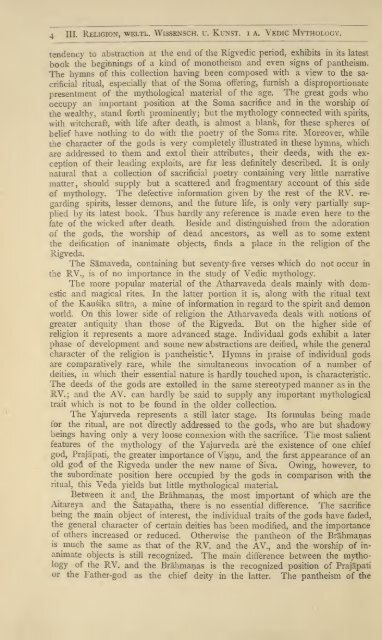Create successful ePaper yourself
Turn your PDF publications into a flip-book with our unique Google optimized e-Paper software.
4 III. RELIGION, WELTL. WISSENSCH. u. KUNST. i A. VEDIC MYTHOLOGY.<br />
tendency to abstraction at the end of the Rigvedic period, exhibits in its latest<br />
book the beginnings of a kind of monotheism and even signs of pantheism.<br />
The hymns of this collection having been composed with a view to the sa<br />
crificial ritual, especially that of the Soma offering, furnish a disproportionate<br />
presentment of the mythological material of the age. The great gods who<br />
occupy an important position at the Soma sacrifice and in the worship of<br />
the wealthy, stand forth prominently; but the <strong>mythology</strong> connected with spirits,<br />
with witchcraft, with life after death, is almost a blank, for these spheres of<br />
belief have nothing to do with the poetry of the Soma rite. Moreover, while<br />
the character of the gods is very completely illustrated in these hymns, which<br />
are addressed to them and extol their attributes, their deeds, with the ex<br />
ception of their leading exploits, are far less definitely described. It is only<br />
natural that a collection of sacrificial poetry containing very little narrative<br />
matter, should supply but a scattered and fragmentary account of this side<br />
of <strong>mythology</strong>. The defective information given by the rest of the RV. re<br />
garding spirits, lesser demons, and the future life, is only very partially sup<br />
plied by its latest book. Thus hardly any reference is made even here to the<br />
fate of the wicked after death. Beside and distinguished from the adoration<br />
of the gods, the worship of dead ancestors, as well as to some extent<br />
the deification of inanimate objects, finds a place in the religion of the<br />
Rigveda.<br />
The Samaveda, containing but seventy-five verses which do not occur in<br />
the RV., is of no importance in the study of <strong>Vedic</strong> <strong>mythology</strong>.<br />
The more popular material of the Atharvaveda deals mainly with dom<br />
estic and magical rites. In the latter portion it is, along with the ritual text<br />
of the Kausika sutra, a mine of information in regard to the spirit and demon<br />
world. On this lower side of religion the Atharvaveda deals with notions of<br />
greater antiquity than those of the Rigveda. But on the higher side of<br />
exhibit a later<br />
religion it represents a more advanced stage. Individual gods<br />
phase of development and some new abstractions are deified, while the general<br />
1<br />
character of the religion is . pantheistic Hymns in praise of individual gods<br />
are comparatively rare, while the simultaneous invocation of a number of<br />
deities, in which their essential nature is hardly touched upon, is characteristic.<br />
The deeds of the gods are extolled in the same stereotyped manner as in the<br />
RV.; and the AV. can hardly be said to supply any important mythological<br />
trait which is not to be found in the older collection.<br />
The Yajurveda represents a still later stage. Its formulas being made<br />
for the ritual,<br />
beings having<br />
are not directly addressed to the gods, who are but shadowy<br />
only a very loose connexion with the sacrifice. The most salient<br />
features of the <strong>mythology</strong> of the Yajurveda are the existence of one chief<br />
god, Prajapati, the greater importance ofVisnu, and, the first old god of the Rigveda under the new name of Siva.<br />
appearance of an<br />
Owing, however, to<br />
the subordinate position here occupied by the gods in comparison with the<br />
ritual, this Veda yields but little mythological material.<br />
Between it and, the Brahmanas, the most important of which are the<br />
Aitareya and the Satapatha, there is no essential difference. The sacrifice<br />
being the main object of interest, the individual traits of the gods have faded,<br />
the general character of certain deities has been modified, and the importance<br />
of others increased or reduced. Otherwise the pantheon of the Brahmanas<br />
is much the same as that of the RV. and the AV., and the worship of in<br />
animate objects is still recognized. The main difference between the mytho<br />
logy of the RV. and the Brahmanas is the recognized position of Prajapati<br />
or the Father-god as the chief deity in the latter. The pantheism of the

















